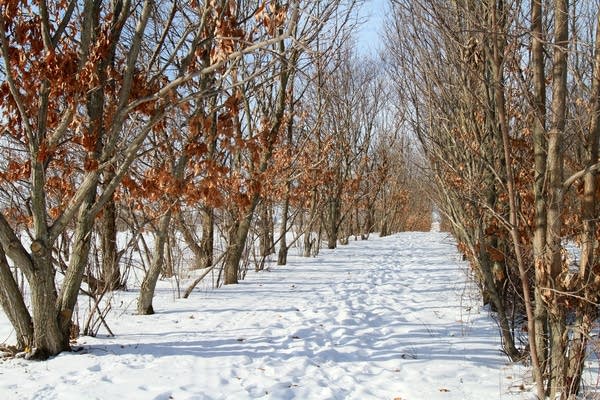MN tree researchers, foodies give American chestnut a second chance

Go Deeper.
Create an account or log in to save stories.
Like this?
Thanks for liking this story! We have added it to a list of your favorite stories.
Long rows of tightly planted American chestnut trees line a field here near the Minnesota-Iowa border. But these aren't your great-grandfather's chestnuts.
Those 80-foot giants with massive trunks — the kind that led Longfellow to write, "Under a spreading chestnut tree, the village smithy stands" — were largely wiped out by an invasive fungus in the early 1900s, nearly eradicating the trees once known as the Redwoods of the East.
In this unlikely patch of southern Minnesota, though, the American chestnut is thriving in a new form, a 40-foot hybrid engineered in a laborious and time-consuming breeding technique, nurtured by a Minnesota researcher with a passion for the trees.
"The first chestnuts that I planted here, we had winter mortality somewhere around 90 percent. They just couldn't stand the winters," said Philip Rutter, who figures he's planted about 40,000 chestnut trees over the years on his 160 acre, completely-off-the-grid farm. "This is the coldest, driest place in the world anybody works with chestnuts at all."
Turn Up Your Support
MPR News helps you turn down the noise and build shared understanding. Turn up your support for this public resource and keep trusted journalism accessible to all.

Trained as an evolutionary ecologist, Rutter has been a leader in the increasingly successful effort to revive the American chestnut for its beauty and what he sees as its potential as an economical source of food. He now serves along with former President Jimmy Carter, as an honorary director of the American Chestnut Foundation. Rutter was the group's founding president in the early 1980s.
On a recent day, Rutter showed off what he's built. He walked toward one of his most productive trees and picked up a chestnut burr that landed on the snow. The seed pod once held three chestnuts inside. The outside looks like a sea urchin about the size of a lemon.
Rutter figures it's a 10-year wait before a tree starts producing nuts. "They'll start to produce flowers when they're 3," he said. "But you don't get good pollination until you've got big trees to really spread pollen out over things."
A century ago, the American chestnut made up about a quarter of the hardwood forests, particularly in the Appalachian region from Georgia to southern Canada. But in 1904, a fungus imported on Chinese chestnut trees, began destroying the trees, and within 30 years, wiped out nearly 4 billion American chestnuts.
The goal of hybridization is to give the American trees the blight resistance of the Chinese chestnut, without its undesirable traits such as shrub-like growth.

Research on genetic engineering and fungal diseases also show promise, said Lisa Thomson, president of the American Chestnut Foundation.
"We are still testing," she said. "We are still learning, and we don't have a perfectly blight-resistant tree yet through the hybridization process."
The hope is that knowledge gained from the American chestnut experiments can help save other species from exotic pests like the emerald ash borer, said United States Forest Service Pathologist Bruce Moltzen. The chestnut's revival, he said, is a step in the right direction.
"The ultimate hope is to one day be able to get a tree that resembles what we once had and these things were quite spectacular," he added. "Not very many people remember how big these trees actually got and what they represented."
Rutter said the rise of the local food movement has helped bump up chestnut sales in recent years. He sells chestnut seedlings online and some of his crop to Rochester and Twin Cities restaurants and co-ops, including the Eastside Co-Op in Minneapolis, Heartland Restaurant in St. Paul, and all three Mississippi Market locations.

He hasn't turned a profit on his operation yet. But with advances in hybridization and genetic engineering, he's convinced that his three decades of investing in chestnuts will soon provide a return.
Rutter poured a couple dozen nuts out of a Mason jar and cracked one open. The nuts are highly nutritious and their value goes far beyond providing a holiday treat, he added.
"Chestnuts used to be a staple. Chestnut bread is older than wheat bread," he said. "One of the simple reasons to do this is they're really good. They're mysteriously tasty food."
Dear reader,
The trustworthy and factual news you find here at MPR News relies on the generosity of readers like you.
Your donation ensures that our journalism remains available to all, connecting communities and facilitating better conversations for everyone.
Will you make a gift today to help keep this trusted new source accessible to all?






